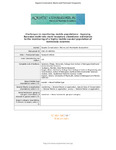Challenges in monitoring mobile populations - Applying Bayesian multi-site mark-recapture abundance estimation to the monitoring of a highly mobile coastal population of bottlenose dolphins
| dc.contributor.author | Ingram, Simon | |
| dc.date.accessioned | 2020-09-04T11:29:16Z | |
| dc.date.issued | 2020-08 | |
| dc.identifier.issn | 1052-7613 | |
| dc.identifier.issn | 1099-0755 | |
| dc.identifier.uri | http://hdl.handle.net/10026.1/16222 | |
| dc.description.abstract |
<jats:title>Abstract</jats:title><jats:p> <jats:list> <jats:list-item><jats:p>Monitoring the abundance of mobile and wide‐ranging cetacean populations for conservation management is challenging, especially when the management is focused on static protected areas. Where abundance estimates are derived from mark–recapture data, such as photo‐identification of naturally marked individuals, unpredictable movements of animals in and out of the survey area can reduce ‘capture’ probabilities and affect the precision and accuracy of resulting estimates.</jats:p></jats:list-item> <jats:list-item><jats:p>A Bayesian hierarchical log–linear model was applied to photo‐identification data collected in summer 2014 to derive a multi‐site abundance estimate for a population of bottlenose dolphins, <jats:styled-content style="fixed-case"><jats:italic>Tursiops truncatus</jats:italic></jats:styled-content>, ranging widely throughout the coastal waters of western Ireland. In addition, the effects of varying levels of sampling effort on the minimum detectable decrease in population size were examined.</jats:p></jats:list-item> <jats:list-item><jats:p>The abundance (median) of dolphins was estimated as 189 (coefficient of variation (standard deviation/mean), 0.11; 95% highest‐posterior density interval, 162–232). Over 50% of the well‐marked dolphins encountered throughout the study were sighted in more than one distinct coastal area, thus displaying high mobility. In addition, it was found that it would require biennial surveys to detect a 25% decline in abundance within the six‐year reporting period of the EU’s Habitats Directive.</jats:p></jats:list-item> <jats:list-item><jats:p>Given that the Special Area of Conservation designated for these dolphins consists of two separate areas covering a substantial portion of the west coast of Ireland, the multisite approach is appropriate for monitoring this population. It produces a more precise estimate and is well suited for sparse recapture data collected opportunistically at multiple sites, when the lack of resources prevents large‐scale surveys or when concentrating surveys on smaller localized areas fails to capture the broad range and unpredictable occurrence of the animals. The Bayesian multi‐site approach could be applied to the management of other wide‐ranging marine or terrestrial taxa.</jats:p></jats:list-item> </jats:list></jats:p> | |
| dc.format.extent | 1674-1688 | |
| dc.language | en | |
| dc.language.iso | en | |
| dc.publisher | Wiley | |
| dc.subject | coastal | |
| dc.subject | mammals | |
| dc.subject | monitoring | |
| dc.subject | special area of conservation (SAC) | |
| dc.subject | survey | |
| dc.title | Challenges in monitoring mobile populations - Applying Bayesian multi-site mark-recapture abundance estimation to the monitoring of a highly mobile coastal population of bottlenose dolphins | |
| dc.type | journal-article | |
| dc.type | Journal Article | |
| plymouth.author-url | https://www.webofscience.com/api/gateway?GWVersion=2&SrcApp=PARTNER_APP&SrcAuth=LinksAMR&KeyUT=WOS:000547660100001&DestLinkType=FullRecord&DestApp=ALL_WOS&UsrCustomerID=11bb513d99f797142bcfeffcc58ea008 | |
| plymouth.issue | 8 | |
| plymouth.volume | 30 | |
| plymouth.publication-status | Published | |
| plymouth.journal | Aquatic Conservation: Marine and Freshwater Ecosystems | |
| dc.identifier.doi | 10.1002/aqc.3355 | |
| plymouth.organisational-group | /Plymouth | |
| plymouth.organisational-group | /Plymouth/Faculty of Science and Engineering | |
| plymouth.organisational-group | /Plymouth/REF 2021 Researchers by UoA | |
| plymouth.organisational-group | /Plymouth/REF 2021 Researchers by UoA/UoA07 Earth Systems and Environmental Sciences | |
| plymouth.organisational-group | /Plymouth/Research Groups | |
| plymouth.organisational-group | /Plymouth/Research Groups/Marine Institute | |
| plymouth.organisational-group | /Plymouth/Users by role | |
| plymouth.organisational-group | /Plymouth/Users by role/Academics | |
| dcterms.dateAccepted | 2020-04-06 | |
| dc.rights.embargodate | 2021-7-2 | |
| dc.identifier.eissn | 1099-0755 | |
| dc.rights.embargoperiod | Not known | |
| rioxxterms.versionofrecord | 10.1002/aqc.3355 | |
| rioxxterms.licenseref.uri | http://www.rioxx.net/licenses/all-rights-reserved | |
| rioxxterms.licenseref.startdate | 2020-08 | |
| rioxxterms.type | Journal Article/Review |


